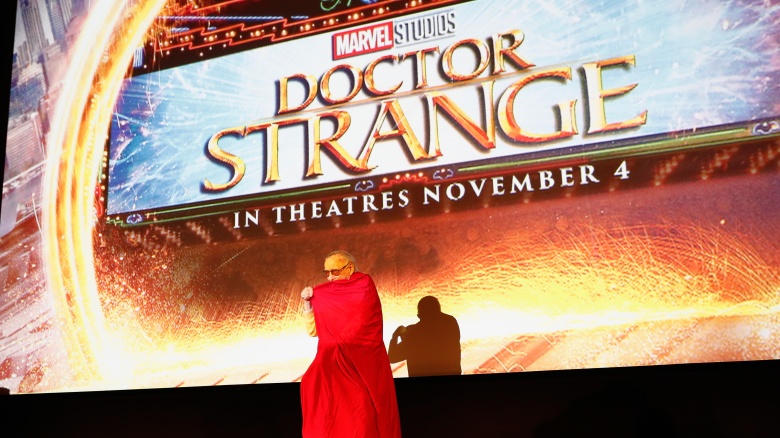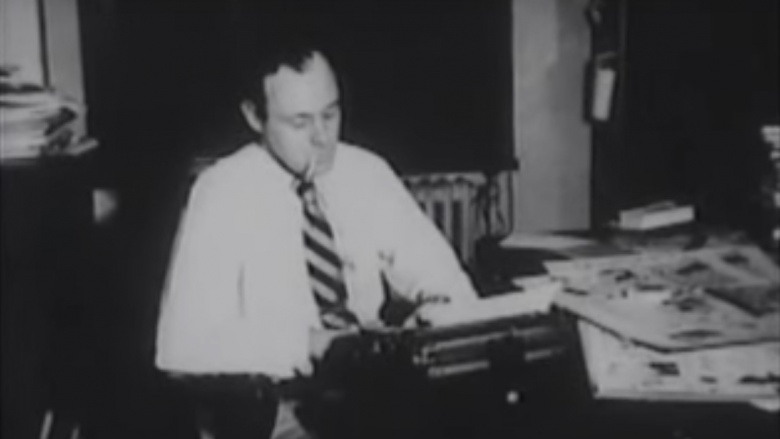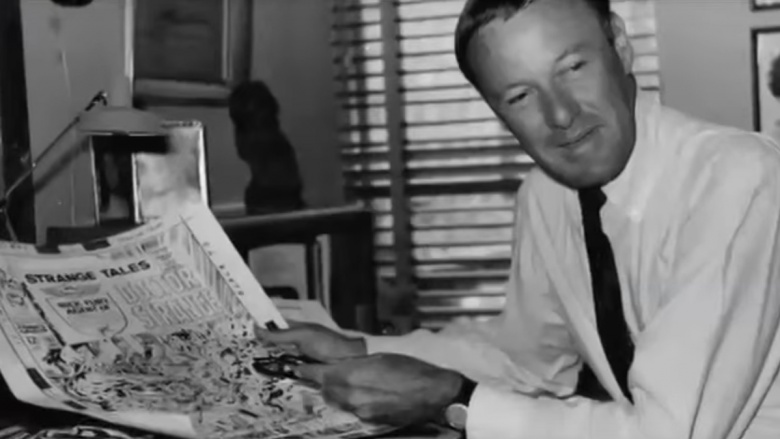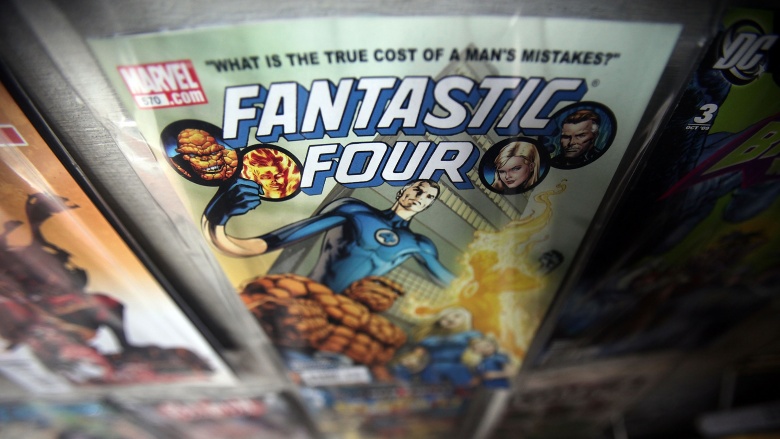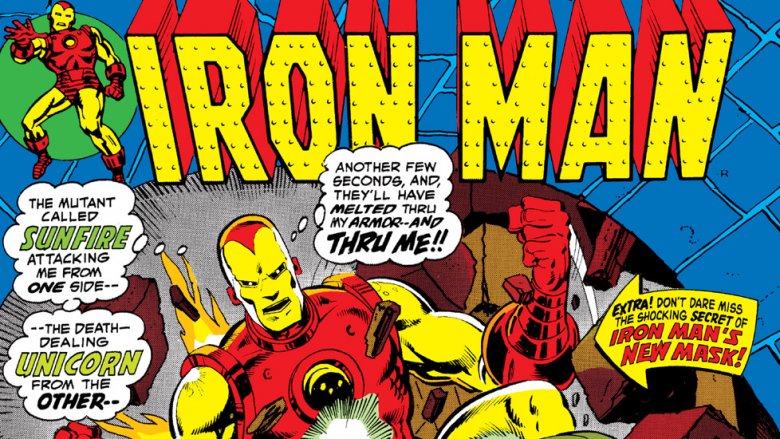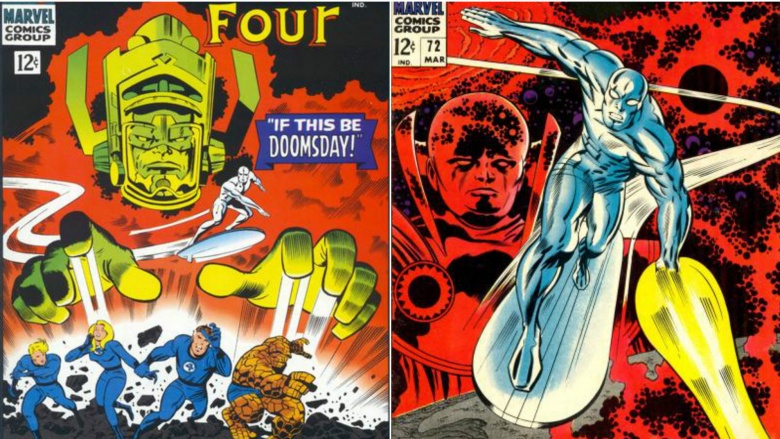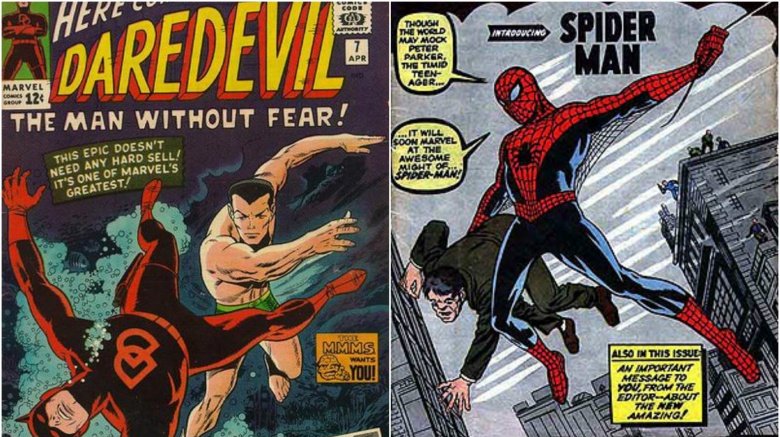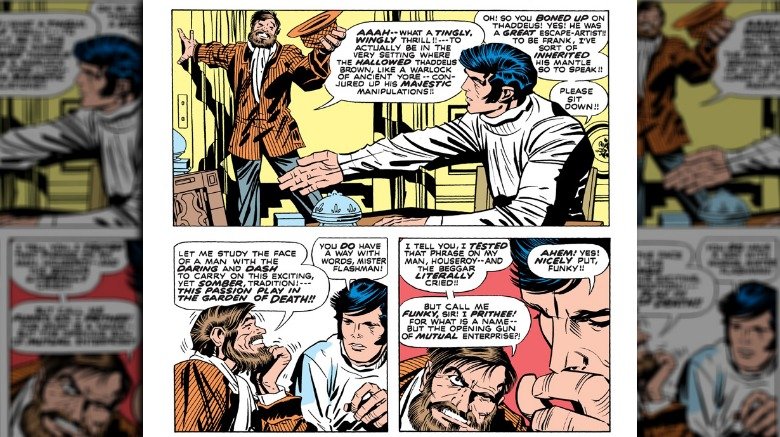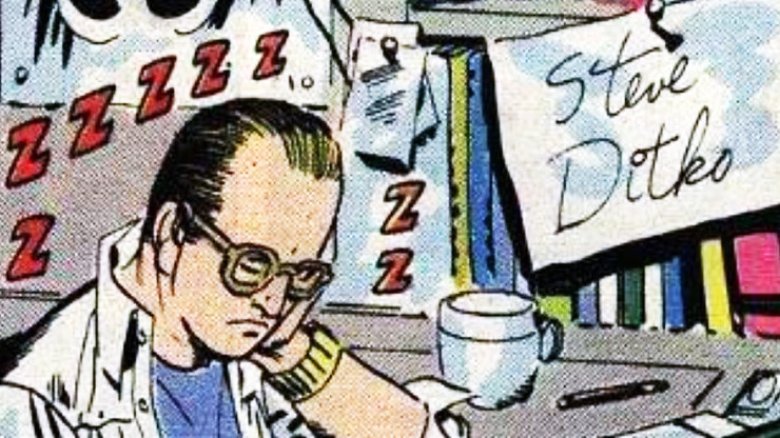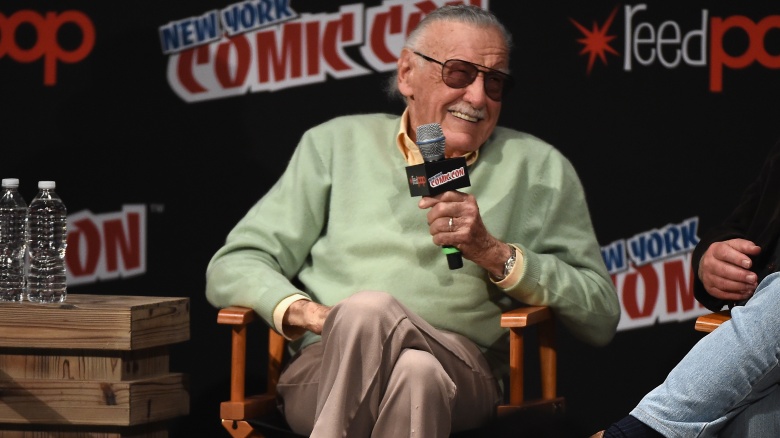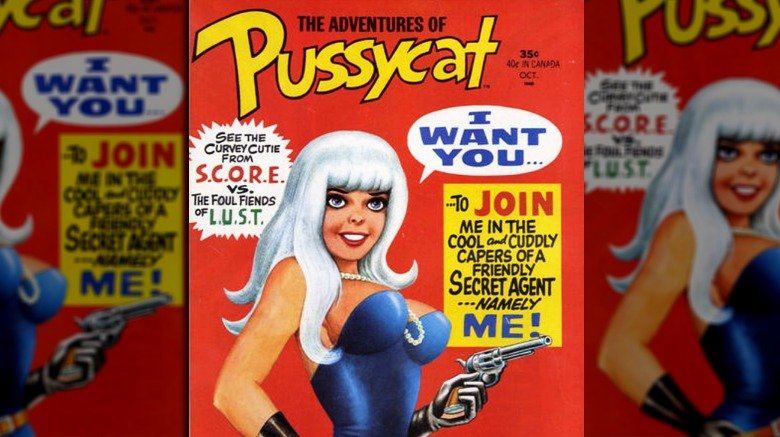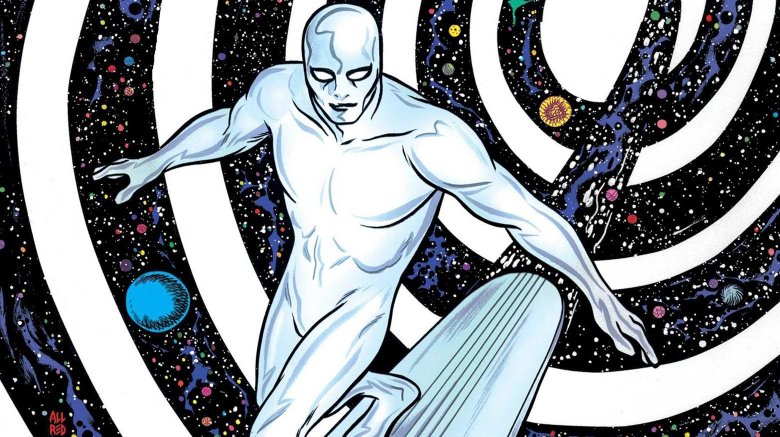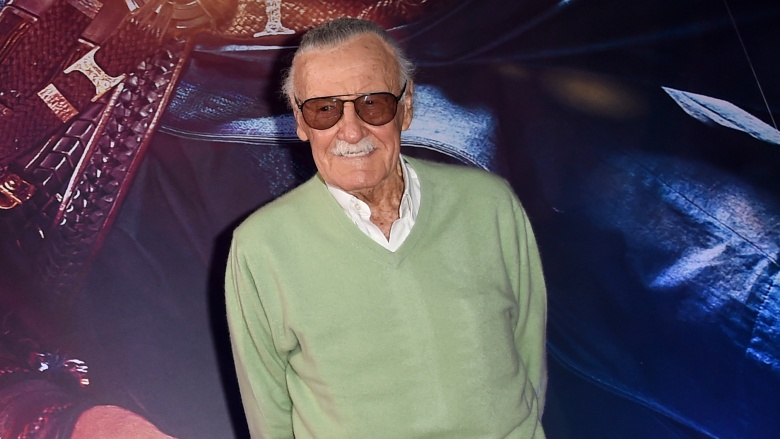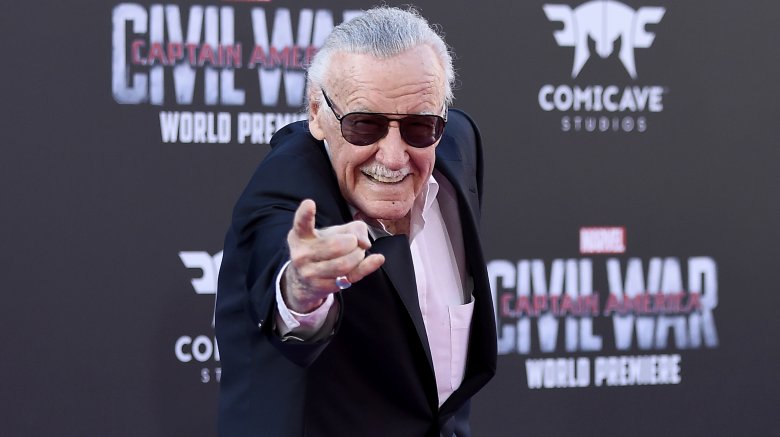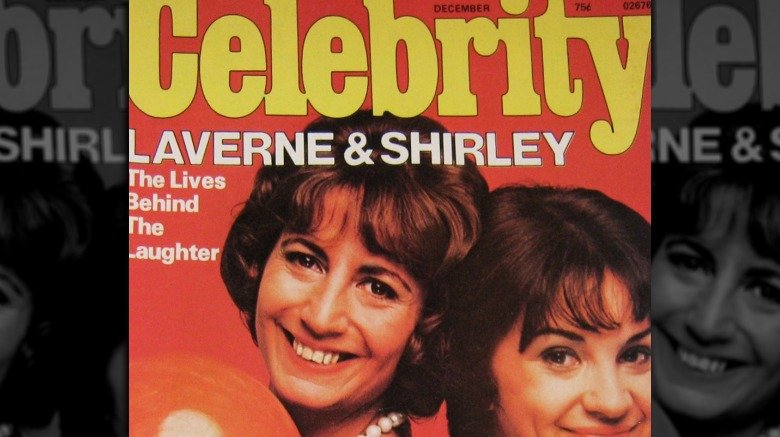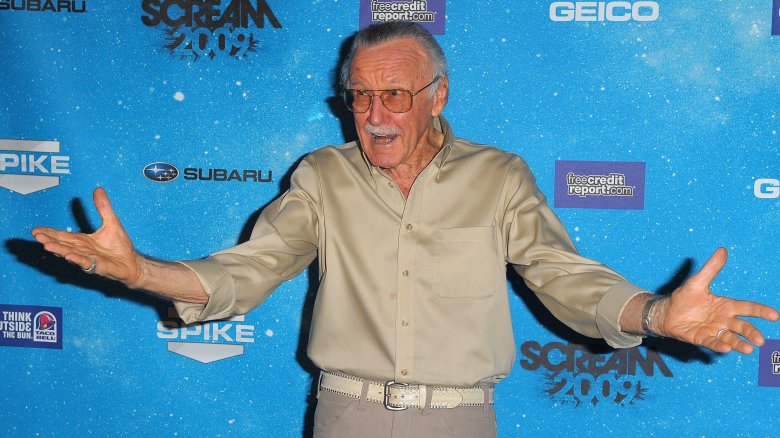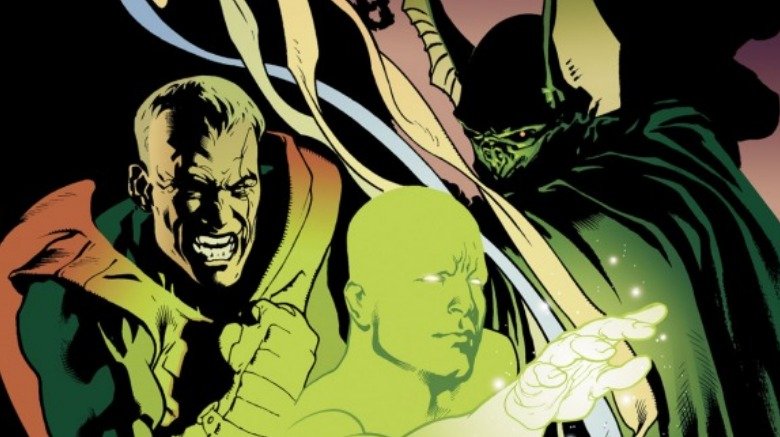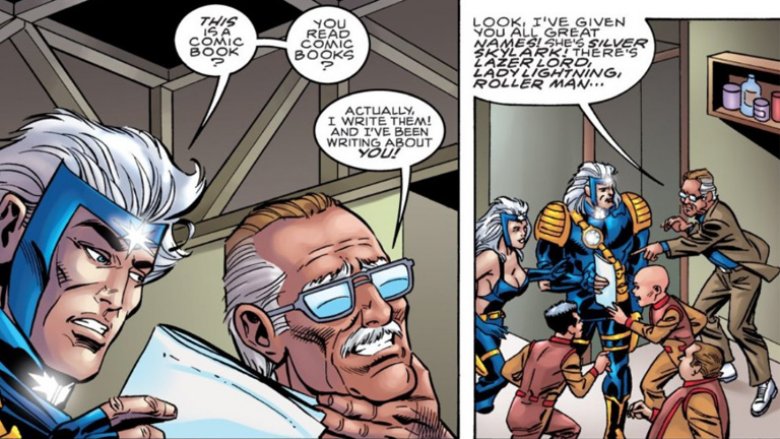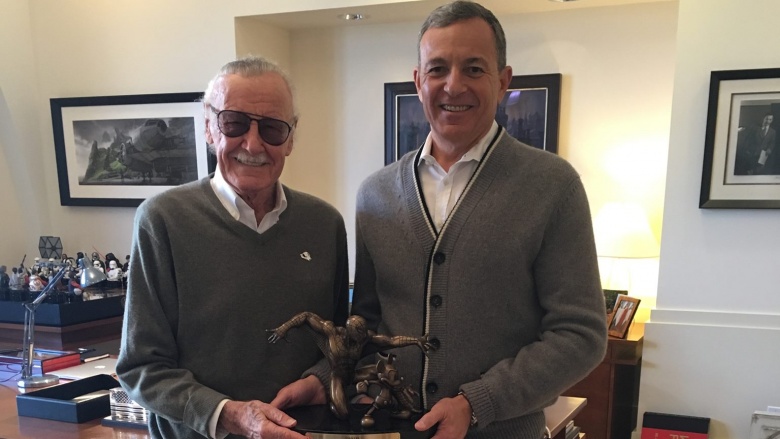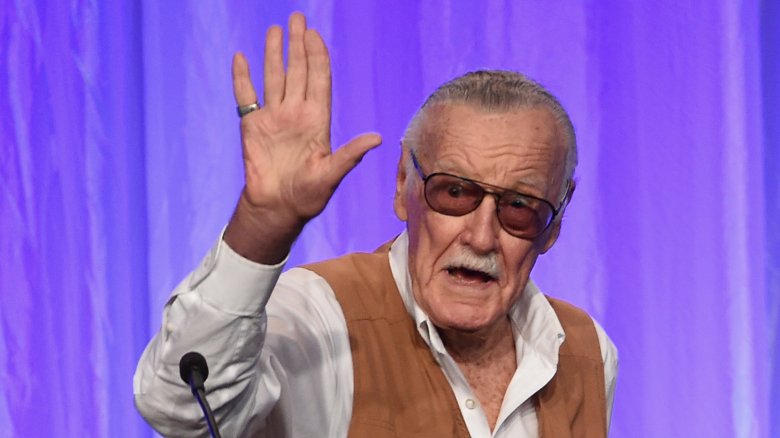The Untold Truth Of Stan Lee
Everyone knows Stan Lee as the lovable old grandpa of the Marvel Universe, popping up in the regular movie cameos that have technically made him one of the highest-grossing screen stars of all time, but that's only the latest phase of a superheroic career that started way back in 1939. Sadly, Stan passed away in November 2018 at the age of 95, but he left behind a long and well-lived life of remarkable achievements that changed comic books and pop culture. With such a fascinating life in and out of the public eye, there's still plenty that many Marvel fans don't know about his legacy. Here's the untold truth of Stan Lee.
Need a good job? Get a rich relative!
Stan Lee was born Stanley Martin Lieber in 1922, which was perfect timing to enter the workforce during the Great Depression. He was always interested in writing and made some extra cash in school by drafting preemptive obituaries for famous people the papers thought might die soon. When he turned 18, he got a job with Timely Comics, the company which would later make a fateful name change to Marvel. At the time, the company was owned by Martin Goodman, who was married to Lee's cousin. How much this family connection helped Lee get the job remains disputed, with Captain America creator Joe Simon remarking that "Stan was always embarrassed about being related to Martin." Lee even claimed that Goodman had no idea he worked there until they bumped into each other in the hall, although Simon says that can't be true, since "we didn't have a hall."
He's all right, but Stan started as a 'gofer'
Stan Lee originally worked as a "gofer," filling inkwells and getting lunch, but soon started writing for the company as well. At the time, he assumed his career in comics would be short-lived and didn't really want his name to be associated with such a lowbrow art form, since it might hurt his ambition to become a respected novelist. As a result, he adopted "Stan Lee" as a pen name and spent years introducing himself to people as simply "a writer," since if he admitted it was for comic books "they would avoid me like the plague." Ironically, his comic writing later made him a celebrity under his pseudonym, to the point that he legally adopted it as his real name.
Stan got the best temp job ever!
Stan Lee had been working at Marvel for less than a year when veterans Joe Simon and Jack Kirby discovered that Martin Goodman had been stiffing them out of royalties on Captain America. The pair were supposed to get 25 percent of the profits between them, but Goodman had been deducting the expenses of the whole office from the Captain America sales, making profits much lower than they should have been. Outraged, Kirby and Simon quit Timely for National Comics (which later became DC).
Goodman immediately appointed the 19-year-old Stan Lee to replace Simon as editor-in-chief. At the time, he had mostly written short "filler" comics, as well as brief text stories that were only included so the comics could technically qualify as "magazines" and get a cheaper rate on postage. Lee himself says the appointment was supposed to be temporary, but Goodman became distracted with other branches of his publishing company and forgot to replace him. As it turned out, Lee remained in the post for the next three decades (he's pictured above in the 1960s), although he did take a few years out to serve in the army during WWII, where he designed anti-VD posters reading "VD? Not Me!"
DC inspired Stan, Stan inspired generations of readers
After World War II, superhero comics suffered a shockingly rapid decline in popularity. By 1954, only Batman, Superman, and Wonder Woman could still support their own series. Over at Timely, all superhero comics were canceled, and Stan Lee kept the company going by focusing on crime, horror, and westerns. Desperate to stay in business, Lee had little room for creativity: "Whatever other people were selling, we would do the same thing."
Despite these efforts, the company repeatedly risked bankruptcy during the 1950s, to the point that Jack Kirby says he once came in to find Lee sobbing while men removed the office furniture. Goodman eventually made Lee fire all the other employees, including many of his closest friends. Lee himself felt terrified at the prospect of looking for work with "Silly Seal and Ziggy Pig" on his CV, but Goodman ultimately kept him on as "a human pilot light, left burning in the hope that we would reactivate our production at a future date."
When Lee was 39, he told his wife that he wanted to quit, since "I don't think I'm getting anywhere." Fortunately, DC had recently reinvigorated superhero comics and were having great success with their Justice League team. In an attempt to replicate those sales, Lee and Jack Kirby co-created the Fantastic Four, a huge hit that saved the company and changed comics history.
[credit=]
He was so overworked he gave Iron Man a nose
In the early days of Marvel, Stan Lee was scripting multiple books every month while also serving as editor. As the years went on, he would hand books off to other creators (Amazing Spider-Man and Fantastic Four were the only ones he stayed on for over 100 issues). Lee still maintained the position of overseeing and approving the entire line in addition to being the public face of Marvel Comics. That was a lot of work, and, in 1974, it hit critical mass in the weirdest possible way.
At the time, Stan had moved to the position of publisher (a job that he would later leave after claiming that it was more about the business side of the industry than the creative work he enjoyed). While a series of successors filled the role of editor-in-chief, Stan still had the final say on what happened in the books. When he was looking at an issue of Iron Man, he asked Roy Thomas, his former assistant, who had been promoted to EiC, why his helmet didn't have room for a nose. Thomas assigned artist George Tuska to fix the "problem," and in Iron Man #68, the armored Avenger debuted a new helmet with a big triangular nose on his face mask.
Needless to say, it looked pretty silly. So silly, in fact, that according to an issue of Marvel Age, when Stan picked up an issue of Iron Man a year later, he asked why Iron Man had a nose on his armor. He had completely forgotten he asked for it in the first place.
His artists did a lot of the work
Over the next few years, the company changed its name to Marvel and Stan Lee co-created Thor, Iron Man, Spider-Man, Daredevil, Hulk, and the X-Men. To juggle so many series, Lee pioneered the "Marvel Method." Instead of producing a panel-by-panel script for each issue, Lee would come up with a rough outline of the story and let the artist work from there. Once he got the finished artwork, Lee would "try to figure out what the illustrations meant and then put in the dialogue and captions," which he described as "like doing a crossword."
As a result, the artists were responsible for coming up with much of the plot. For example, a classic storyline saw the Fantastic Four face the planet-devouring Galactus and his herald, the Silver Surfer. After suggesting the team fight a godlike figure, Lee left matters with Jack Kirby and responded to receiving the artwork by pointing at the Silver Surfer and asking, "Who the hell's this?" Other Kirby artwork from the period includes notes telling Lee what's supposed to be happening in each panel, and even making dialogue suggestions.
Creator credit -- the long-time dispute
The "Marvel Method" produced some great comics, but it also caused a rift between Stan Lee and Marvel's artists, who felt he was hogging credit and payment for stories they had at least co-written. Jack Kirby and Steve Ditko, the other members of Marvel's "Holy Trinity," also resented that the charismatic Lee had become the face of the company. Ditko eventually stopped speaking to Lee at all and left Marvel in 1966. Kirby followed Ditko out in 1970 and soon kicked off a huge controversy by claiming that he alone had created hit characters like the Hulk, Thor, and the Fantastic Four.
According to Kirby, Lee contributed virtually nothing but used his power as editor to make sure he was credited anyway. He later railed that "Stan Lee wasn't a guy that read or that told stories ... It wasn't possible for a man like Stan to come up with new things, or old things, for that matter." Daredevil artist Wally Wood was just as scathing, writing that Lee only ever "came up with two surefire ideas ... the first one was 'Why not let the artists write the stories as well as draw them?' And the second was 'Always sign your name on top — BIG!'"
On the other hand, Spider-Man artist John Romita Sr. defended Lee, telling Jon B. Cooke that he "would bet my house that Jack never read the books after Stan wrote them; that's why he could claim with a straight face that Stan never wrote anything ... [Stan's] a con man, but he did deliver ... that's why I never begrudged him getting any of the credit, and as far as I'm concerned, he can have his name above my stuff anytime he wants."
King Kirby and the Funky Flashman
On the page, Stan Lee and Jack Kirby were the team responsible for building the majority of the Marvel Universe and telling some of the best comic book stories of all time. They were the creators of Fantastic Four, The Uncanny X-Men, The Incredible Hulk, The Mighty Thor, The Avengers and the pair that breathed new life into older characters like Namor the Sub-Mariner and Kirby and Joe Simon's Captain America. Behind the scenes, however, things weren't quite so friendly. Even as they collaborated, Kirby was growing more and more frustrated with Lee. To Kirby, Stan was the consummate corporate creator, serving as the editor-in-chief and the public face of the company that Kirby saw as exploiting his talent — and personally taking credit for Kirby's ideas. And when Kirby finally left Marvel for DC, he wasted no time in making his feelings known in the best way he knew how: by turning his collaborator-turned-nemesis into a comics character.
After asking readers "I know him, you know him, but does anyone need him?" Kirby introduced Funky Flashman in the pages of Mister Miracle #6 as the world's most poorly disguised caricature. Accompanied by a sniveling minion named Houseroy (thought to be based on Roy Thomas, Stan's assistant who later became Marvel's second editor-in-chief), Flashman was extremely allergic to hard work and was first seen taking money that was automatically dispensed from a statue, literally pulling the money out of its head. To make matters worse, Kirby blasted Lee in an interview with The Comics Journal in the '80s, calling him a "pest" who only got work at Marvel because he was related to the publisher, boldly claiming "I've never seen Stan Lee write anything."
The story does have a happy ending though. According to Sean Howe's Marvel Comics: The Untold Story, Kirby and Lee had a chance meeting in San Diego at Comic-Con International in 1993 and were able to speak to each other as friends one last time. Kirby would die later that year, and — after asking permission from Kirby's widow, Roz — Lee attended his funeral.
Steve Ditko's silent treatment
If Stan Lee's partnership with Jack Kirby deteriorated into enmity, his relationship with Spider-Man and Doctor Strange co-creator Steve Ditko went in a different direction. It became nonexistent. Ditko had always been a little intense. He was, for instance, the only member of the Marvel bullpen who refused to appear on the Voices of Marvel record, a truly bizarre artifact given to members of the Merry Marvel Marching Society fan club where the original staff, led by Lee, wandered through skits about working on comics. Given the quality of the jokes, Ditko's lack of interest is understandable. Another bone of contention was, according to Marvel Comics: The Untold Story, when Stan put a blurb on a title page claiming that an issue had been voted "Most Likely to Succeed (By Stan and Steve)," a joke which rubbed Ditko the wrong way — he demanded Lee change it since no such vote had taken place.
As his tenure on Amazing Spider-Man continued, Ditko attempted to inject the stories with references to Ayn Rand's Objectivist philosophy, in which he was an ardent believer. That put him at odds with Lee, who was writing the dialogue. Eventually, they just stopped speaking to each other, even as they continued working on Amazing Spider-Man. The final straw came when the two creators disagreed over the true identity of Spider-Man villain the Green Goblin. Lee wanted it to be Norman Osborn, the father of Spider-Man's best friend; Ditko allegedly wanted the Goblin to be an unrelated criminal. Lee won the argument. Ditko exited the book and was replaced by John Romita Sr., who stayed with Marvel for many years.
For his part, Ditko would work on and off for Marvel and DC for the next few decades and is still creating and publishing comics on his own today, usually with a hardcore Randian bent like the work seen in his comic Mr. A. Ditko does not, however, do any interviews, and despite co-creating one of the 20th century's most popular fictional characters, has no interest in talking about his time at Marvel.
His porn was terrible
In 1975, Stan Lee teamed up with John Romita Sr. to pitch a pornographic comic strip to Playboy magazine. According to the pitch, the strip was to center on the adventures of Thomas Swift, the "first heterosexual to receive the coveted Golden Sperm award for paranormal sexual proclivities." The main character would be "as American as apple pie, the stars and stripes, baseball, and Sunday lynchings" and would face all sorts of sexy threats with the help of his girlfriend, Margo Tender, who had been seduced by Thomas while selling Girl Scout cookies door to door. (The '70s were a very creepy era.)
In the proposed first storyline, Thomas would go up against a race of aliens with penis-shaped heads, led by Lord Peckerton and High Priestess Clitanna. However, Playboy wasn't completely sold on the first draft, writing back that while "Mr. Hefner loves the pecker-heads," they wanted more sex monsters, funnier names, and possibly an "evil black stud." At that point, Romita got cold feet, later telling Comics Reporter that "I'm really a prude ... I tried twice to make it raunchier. And I thought an orgasm machine was pretty raunchy, the girls were all completely nude, you know? [Playboy] asked for more." Lee said he wouldn't do the comic without Romita (who called it "the only time I can point to Stan passing up a chance to make money"), and the idea was dropped, which was probably fortunate for everyone involved.
Pussycat: Agent of S.C.O.R.E.
In the 1960s, Marvel was just a small division of a company called Magazine Management, and while Stan Lee and the other creators in the original bullpen were revolutionizing superheroes, they weren't actually the most profitable part of the company. That honor, dubious as it might be, went to a line of softcore "Men's Magazines" with names like Complete Man, Male, and Stag. The names, as you can see, are very creative.
Lee, sensing an opportunity to capitalize on the success that former Mad editor Harvey Kurtzman was having with a strip called Little Annie Fannie that ran in Playboy, decided that there might be some success to be found by combining Magazine Management's two most prominent departments. The result was what he called a "nudie-cutie" comic called The Adventures of Pussycat, which made its debut in the pages of Male in 1965. As befitting the era where James Bond and The Man From U.N.C.L.E. were ruling pop culture, Pussycat's "misadventures of a magnificently proportioned miss" focused on a naive secretary working for a secret organization called S.C.O.R.E. — the Secret Council of Ruthless Extroverts — as they sought to thwart their nemeses in L.U.S.T. And just in case you were wondering how much effort was put into the plots of these comics, L.U.S.T. didn't actually stand for anything.
While the original story was plotted and drawn by Wally Wood, who was no stranger to the erotic side of comics, Lee would later script issues drawn by artists Jim Mooney and Al Hartley, the latter of whom would leave Marvel after providing art for the softcore strip and devote much of his career to drawing Christian-themed comics stories. Needless to say, despite having an incredible roster of talent behind it, including Lee, Wood, Mooney, Sub-Mariner creator Bill Everett, and more, Marvel is in no hurry to acknowledge the existence of Pussycat. The strips have only been reprinted once in the '60s. However. a character named Agent Pussycat, inspired by the original version, did make an appearance in a 2012 issue of Defenders.
The mighty Marvel movie pitch man
In 1981, Stan Lee moved to Hollywood with the goal of securing movie deals for Marvel's biggest properties. Unfortunately, this was years before Tim Burton's Batman and decades before the comic book movie boom of the 2000s. Studios just weren't willing to put big money into superhero movies. In fact, the only Marvel character that did get a major film deal was Howard the Duck, which resulted in one of the biggest flops of the 1980s.
Lee did come agonizingly close to landing a $20 million Silver Surfer movie. The producers even hired distinguished engineer Eric Laithwaite to build an electromagnetic "levitation device" for the Surfer to glide on, for which he produced a video demo for the studio. However, the deal eventually fell through, which might be for the best considering Lee's original plot outline includes a black gangster named "Sweet-Daddy Wisdom" who aims to capture "the world's ultimate honky." But while Lee's time in Hollywood didn't result in the movies he hoped for, Marvel's recent success makes it clear he was just ahead of his time.
He wasn't as rich as you think -- or was he?
Although he was the public face of Marvel from the 1960s onward, Stan Lee was always an employee and never owned the rights to the characters he co-created. In fact, he even had to sue Marvel in 2002, claiming that the company failed to honor an agreement to pay him 10 percent of the profits from any movies featuring his characters. The case was settled out of court in 2005, with Lee dropping his claim in return for around $10 million.
That probably seemed like a good deal at the time since Marvel wasn't producing its own movies and only received a small portion of the profits from outside productions like Spider-Man. However, shortly after Lee settled, Marvel launched its own film studio and was soon raking in billions from hits like Iron Man and The Avengers. Despite potentially losing hundreds of millions, Lee insisted he wasn't bitter, telling Playboy that "my daughter was looking at the internet the other day and read that Stan Lee has an estimated $250 million. I mean, that's ridiculous! I don't have anywhere near that ... I never dreamed I should have $100 million or $250 million or whatever that crazy number is. All I know is I created a lot of characters and enjoyed the work I did."
He revolutionized comic book writing
In a single decade, from 1961 to 1971, Stan Lee's Marvel unveiled almost every classic character in the company's stable, from the Hulk to Spider-Man. Although his role in creating these characters is disputed, Lee unquestionably wrote the dialogue and that alone should be enough to cement his legacy. For the first time, superheroes seemed like real people, who cracked jokes and worried about paying the bills (the Fantastic Four actually went bankrupt in their ninth comic). While the lantern-jawed heroes of DC were loved by all, Marvel characters like Spider-Man and the X-Men found that their powers attracted hatred and fear — the Hulk, for example, was a nightmarish monster terrified of his own abilities. Through it all, Lee's snappy, reference-loaded dialogue crackled off the page. Comics would never be the same again.
Lee liked to hobnob
Stan Lee's attempts at breaking out of comics and into the other areas of the newsstand were not limited to the world of men's adventure magazines. In the late '70s, he launched Celebrity, a knockoff of People mainly notable for two things. First, it apparently fawned over its subjects. Second, more often than not, its articles featured Lee himself hobnobbing with c-list celebrities and bygone stars.
The whole thing was best summed up by James Monaco in Celebrity: The Media as Image Makers, where he wrote, "If Celebrity's attitude toward the phenomenon seems diffident, that may be because it is published by Stan Lee of Marvel Comics fame, and primarily devoted to the exploits of Lee, the first comic book author to gain celebrity status." While it ran for a few years, the magazine was never a hit, and when Marvel's parent company was looking to save money, Lee's self-aggrandizing adventures alongside Lucille Ball and Peter Frampton got the axe along with the entire roster of softcore men's mags.
The Comic Book Greats come to VHS!
It's easy to argue that Stan Lee's most important role wasn't as a comic book writer or editor but as an ambassador for the medium. Long before he was a notable cameo in the world's most popular movies, he served his ambassador role via a set of videos designed to give viewers a look behind the scenes of the comic book industry.
Released on VHS in 1991, The Comic Book Greats was a 12-part documentary series hosted by Lee where he interviewed creators about their process. Not only did it feature legends like Mad artists Sergio Aragones, Harvey Kurtzman, Jack Davis, and Batman co-creator Bob Kane, it also put the spotlight on some of the hottest creators of the era. Part 7 saw Lee sitting down with Chris Claremont at the end of his 17-year run as the writer of X-Men, discussing how he helped to make them Marvel's most popular franchise.
Among the most interesting segments were when Lee interviewed Jim Lee, Todd McFarlane, Rob Liefeld, and Whilce Portacio, four of the artists whose incredible success at Marvel would lead them to found Image Comics. McFarlane and Liefeld's interviews actually managed to feature obscure first appearances of a characters that would later make their way into the comics. Challenged by Lee to create a whole new hero or villain on a tight time limit, McFarlane created a character called "Overkill" that would later become "Overt-Kill" in the pages of Spawn. Similarly, the character who would later be seen in Youngblood as Chapel was designed by Liefeld in his segment, introduced as "Cross, the man you don't want to cross!"
A company with his name sued Marvel for over ten years
Stan Lee always had a knack for following trends, so it's no surprise that in 1998, he co-founded a company called Stan Lee Media in order to produce "webisodes" for an Internet audience — including an animated comic about the Backstreet Boys. It also shouldn't be surprising that in 2000, when the dotcom bubble burst, SLM went defunct and filed for bankruptcy. What happened after that? It's pretty shocking.
After filing for Chapter 11, Stan Lee Media became what industry magazine ICV2 called "a sleazy internet start-up that could function as the poster child for the excesses of the turn-of–the-century era" made up of an "unsavory bunch of white collar grifters" and "bottomfeeders ... attempting to strike it rich through legal action against Stan Lee and Marvel." The short version is that they claimed that Lee assigned all of the rights to his characters to the company, and they sued Marvel, Disney, and Lee himself for billions of dollars. It probably goes without saying, but the lawsuits and appeals were consistently called "frivolous" and dismissed in court.
It's worth noting that Lee himself did his best to extract himself from both the company and its legal mess. Unfortunately, the one thing that wasn't in dispute is that they owned the name "Stan Lee Media," linking Lee's name to their actions despite his best efforts to shut them down.
He re-created the Justice League at DC Comics
Stan Lee is, of course, known for his work at Marvel Comics, but in 2002 he did a pretty huge project for DC: reimagining and re-creating all of their major superheroes in a series called Just Imagine.
According to the credits pages, the project was initiated by Michael Uslan, the occasional comic book writer far more well-known as being the producer of every Batman movie since 1989. Lee was teamed up with a roster of superstar artists including Jim Lee, and, while he kept the names, virtually everything else about the characters was up for grabs. Superman, for instance, was an alien cop who was stranded on Earth while pursuing an intergalactic criminal and had to eliminate crime, which the hero saw as an obstacle to humanity developing the technology that could one day teleport him home. Wonder Woman was an environmental activist who gained the powers of the Incan sun god Manco Capac. Perhaps the strangest was Lee's take on Batman, a masked pro wrestler named Wayne Williams who used the money he made in the ring to fund a vigilante career.
While the books were a big deal at the time, they're not generally considered to be Lee's best work. They have, however, managed to stick around for a while as part of DC's Multiverse. The world of the Just Imagine books is currently designated as Earth-6 in the comics.
The Mighty 7
One of Stan Lee's weirder projects wasn't just a comic he was writing. It was a comic he starred in: Stan Lee's Mighty 7, published by, believe it or not, Archie Comics. Launched in 2012 with a concept by Lee, Mighty 7 was billed as "the world's first reality comic book," although its relationship to reality was only slightly less tenuous than most comics. Lee also provided help with the script, working alongside writers Tony Blake and Paul Jackson and veteran artist Alex Saviuk.
The premise was pretty simple: Seven aliens, two cops, and five criminals, crash-land on Earth and become superheroes. The difference is that the first person they meet on the planet is Stan Lee — the actual, "real-life" Stan Lee, who wrote comic books. Lee decides that the super-powered aliens would make a great team of heroes, and, in a very Funky Flashman-esque move, decides to mentor them in the fine art of power and responsibility.
Mighty 7 was initially meant to be the first title in a line called Stan Lee Comics, and, at first, it looked to be going well. In addition to the comic, the concept was shopped around for an animated series, and the Hub, the network owned by Hasbro that also launched My Little Pony: Friendship is Magic, ordered a pilot in 2014. Unfortunately for Stan and the 7, the series was never picked up, and while the comic was slated for six issues, only three were released, leaving the series unfinished without ever getting to the part where the team comes together. No other Stan Lee Comics titles were ever put out.
Stan's big 2016 milestone
On November 16, 2016, Stan Lee's Facebook page was updated to include a message marking his 75th anniversary with Marvel — as well as the special celebration held in his honor by Disney chairman Bob Iger, who presented Lee with an individually commissioned bronze statue depicting Spider-Man preparing for battle alongside Mickey Mouse. It's admittedly a cool gift, but considering the billions that have poured into Disney's coffers since they purchased Marvel, throwing Lee a party is really the least the company could do. The guy was still out there filming upcoming MCU cameos, for Pete's sake.
Rest In Peace, Stan
On November 12, 2018, Stan Lee passed away at Cedars-Sinai Hospital, near his home in Hollywood Hills. He was 95 years old.
It's a massive understatement to say that Lee left an incredible impact on pop culture. The personality that came through his work on the page, the engagement he had with fans, and his constant championing of comic books as both an art form and a business inspired generations of fans to believe that they, too, could be a part of these wonderful universes of radioactive spiders and crime-fighting gamma ray monsters. He was the face of an entire industry, and legitimately changed fiction forever.
While his passing leaves behind a notable absence in a world that got to know his cheerful side through the movies, it's worth noting that he lived long enough to not only see the characters that he created with the likes of Jack Kirby, Steve Ditko, John Romita, and more becoming worldwide icons of heroism and villainy, but to become one of those beloved household names himself. Excelsior!

